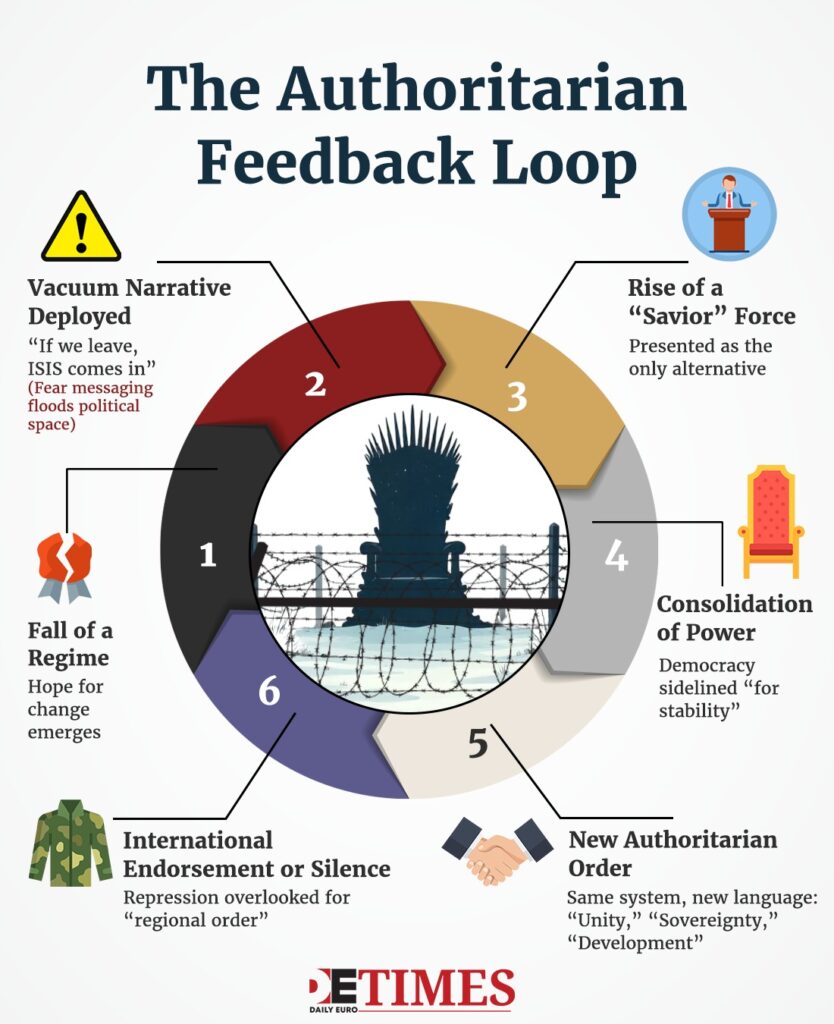Discussions about the fall of authoritarian regimes in the Middle East have long been accompanied by systematic warnings of the “instability” that might follow their absence, just as in Iraq after the fall of Saddam Hussein in 2003, or in Libya in 2011 following the ousting of Muammar Gaddafi.
These warnings are usually presented as realistic assessments of potential risks, but more often or not… they are part of a calculated political narrative aimed at reinforcing the legitimacy of existing regimes, even when they are steeped in repression and corruption.
The Syrian Revolution
Since the beginning of the Syrian revolution, the claim that the fall of Assad’s regime would lead to chaos—or even to terrorism—has been repeated as if tyranny were somehow less harmful than risking a challenging democratic transition. This tone has not disappeared; in fact, it has been repeatedly reproduced in other conflict zones, including Yemen.
Yemen’s Civil War
Not long ago, Yemen’s Deputy Foreign Minister, Mustafa Noman, echoed the same view when he stated in an exclusive interview with the American PBS network.
According to Noman, weakening the Houthis "without a strong alternative may leave a vacuum that is hard to fill, which could be filled by groups like al-Qaeda or ISIS, threatening the security of Yemen and the entire region.”
This belief may seem superficial yet it is used as a tool of deception, especially when voiced by a government that fully understands the extent of the Houthis’ grip and their control over state institutions in the areas under Houthi rule.
The Houthis run sophisticated security, intelligence, and repression networks. The Houthis are not merely a militia temporarily filling a vacuum. The warning about their fall does not reflect a legitimate concern about a “vacuum,” as much as it reflects a political use of the “extremist alternatives” scare tactic to ensure the continuation of the current status quo.
The Fear of the Unknown
This type of rhetoric is nothing new.
Authoritarian regimes have long built their survival narratives on fear of the alternative: the “us or chaos” narrative was never just a passing slogan but a ruling doctrine, feeding the legitimacy of repression and numbing international decision-makers.
Authoritarianism is often compared to a hypothetical “unknown” whose danger is deliberately exaggerated to shut down any serious thinking about democratic transformation or dismantling repressive power structures.
The problem boils down to the validity of the warnings about a vacuum in addition to the deeper truth they ignore: the absence of state institutions during fragile transitional phases. Authorities that seize power without mechanisms of accountability and oversight tend, by their very nature, to reproduce authoritarianism irrespective of their liberatory slogans.
Authoritarianism is not measured by the intentions of its leaders, but by the structure of power, the extent of its monopoly, the absence of institutional frameworks, and the weight of regional interests.
Old Patterns Repeat Themselves: The Independence Era & Syria
After the end of colonialism in the mid-20th century, so-called “national” authorities justified their crimes and violations as they justified their developmental failures, erosion of sovereignty, and suppression of freedoms and democracy.
Power was concentrated in one hand, the press was nationalised, the economy collapsed, and little by little, authoritarianism was reproduced, but this time cloaked in nationalistic language. Thus, the citizen replaced a foreign ruler with a more brutal domestic one, who wore the robes of “liberation” and “independence.”
Today, the same scenario is repeating itself in Syria after the fall of Assad, where violations and dysfunctions are blamed on the transitional period, or justified as part of the fight against the “remnants” of the old regime, while Ahmed al-Sharaa’s hunger for control continues to expand.
For years, the international community feared what would follow Assad’s fall. However, when Assad’s rule collapsed, Western powers ignored the voices and demands of the local population under al-Sharaa’. Washington even offered Sharaa’s regime political reassurances and turned a blind eye to its abuses from the early months, noticeably accountability. In doing so, the regime committed a series of violations, including massacres against minorities, as seen recently in the massacres in Sweida.
Authoritarianism: A Closed Loop System
The most dangerous aspect of the “vacuum” narrative is that it is not only used by old regimes—but is also adopted by emerging forces seeking to reproduce the same system. Ideological militias, such as the Houthis, position themselves as the “only alternative” and warn of any alternatives. In this way, authoritarianism is endlessly reproduced in a closed loop.

Breaking the “vacuum” narrative requires more than just open criticism. It demands tangible alternatives: real institutions, mechanisms of accountability, legal frameworks, a free press, local forces capable of self-organisation, and political will that avoids repeating the mistakes of over-centralisation and isolation.
Societies do not fall into chaos because they rid themselves of a tyrant. Instead, societies fall into a vacuum if they are not given the time or political and economic tools to build what comes after.
The constant invocation of the “vacuum” threat after the fall of authoritarian regimes is not simply naïve political analysis or a justifiable security concern. Instead, it is a recycled and renewed tactic for subjugating societies and preventing any radical shifts toward a democratic or at the very least a civil state.
Confronting it requires building institutional alternatives that uphold the rule of law, accountability, and rights whilst blocking the reproduction of authoritarianism in new disguises.
Stay Up to Date with Related Latest Articles at DET!
Smuggled and Forged: The Houthis’ Shadow Economy
Currency as Strategy: Syria’s Regional Pivot by Money
Zainabiyyat: The Houthis’ Veil of Truth






